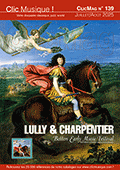 D'origine allemande, Johannes Schenck (1660-après 1712) s'installa à Amsterdam où il s'illustra par le premier opéra en néerlandais. Vers 1696, l'Electeur Palatin l'attira à Düsseldorf comme Kammermusikus und-diener à quoi s'ajoutèrent en 1710 les hautes fonctions financières de Hofkammerrat. En dehors de trois opus de musique vocale en néerlandais, Schenck acquit une grande réputation car il excellait à la viole de gambe et c'est par ses oeuvres pour cet instrument qu'il est principalement connu de nos jours. Son op.7 pour violon, violoncelle et clavecin, dont la moitié nous est proposé dans ce premier enregistrement mondial, fait exception. Son titre 'Suonate' est trompeur car il s'agit d'une compilation de pièces antérieures publiée en 1699: six sonatines, au sens étymologique issu de 'sonare', deux Fantasias, deux Sinfonias, six Capriccios, une Aria et un 'Prelude in stile francese'; mais si Schenck affectionne la succession française allemande-courante-sarabande-gigue, il l'encadre de mouvements de forme libre et d'autres du 'Stylus Phantasticus', créant une synthèse d'éléments français, italien et nord-allemand. La variété est extrême, la longueur des oeuvres allant de 2 à 12 minutes: un pot-pourri des plus divertissants dont l'Ensemble Castor s'amuse brillamment à exploiter les affects. (Michel Lorentz-Alibert)  For some time now, Johannes Schenck has enjoyed a return to popularity as a composer of ingenious and technically demanding music for viola da gamba, but his compositional output in other fields has largely been forgotten. His instrumental music, is nowadays generally recognised, was composed in the tradition of the composer-virtuoso, almost exclusively for the viola da gamba. The only exception is the undated Opus 7, from the publishing house of Estienne Roger, entitled Suonate a Violino e Violone o Cimbalo, which first appeared in 1699. The two individual part-books of the publication, one for the solo violin, the other for the bass accompaniment, contain a total of 18 numbered pieces. The use of French titles for the dance forms and the title “Prelude in stile francese” seem at first to point to a strong French influence on Schenck’s Op. 7, as does the fact that the dance movements are consistently in the ordering Allemande, Courante, Sarabande, Gigue, as was normal practice for a suite in France at the time. But in fact Schenck cleverly mixes suite and sonata forms with formally free, almost improvisatory movements or entire pieces in the so-called Stylus phantasticus, creating a successful synthesis of elements from French, Italian, and Dutch/North German styles. This joy in experimentation leads overall to an impressive diversity of form and great richness of contrast, further increased by means of the contrasting characters of the movements, whose spectrum ranges from playful dances to elegiac slow movements.
 |
